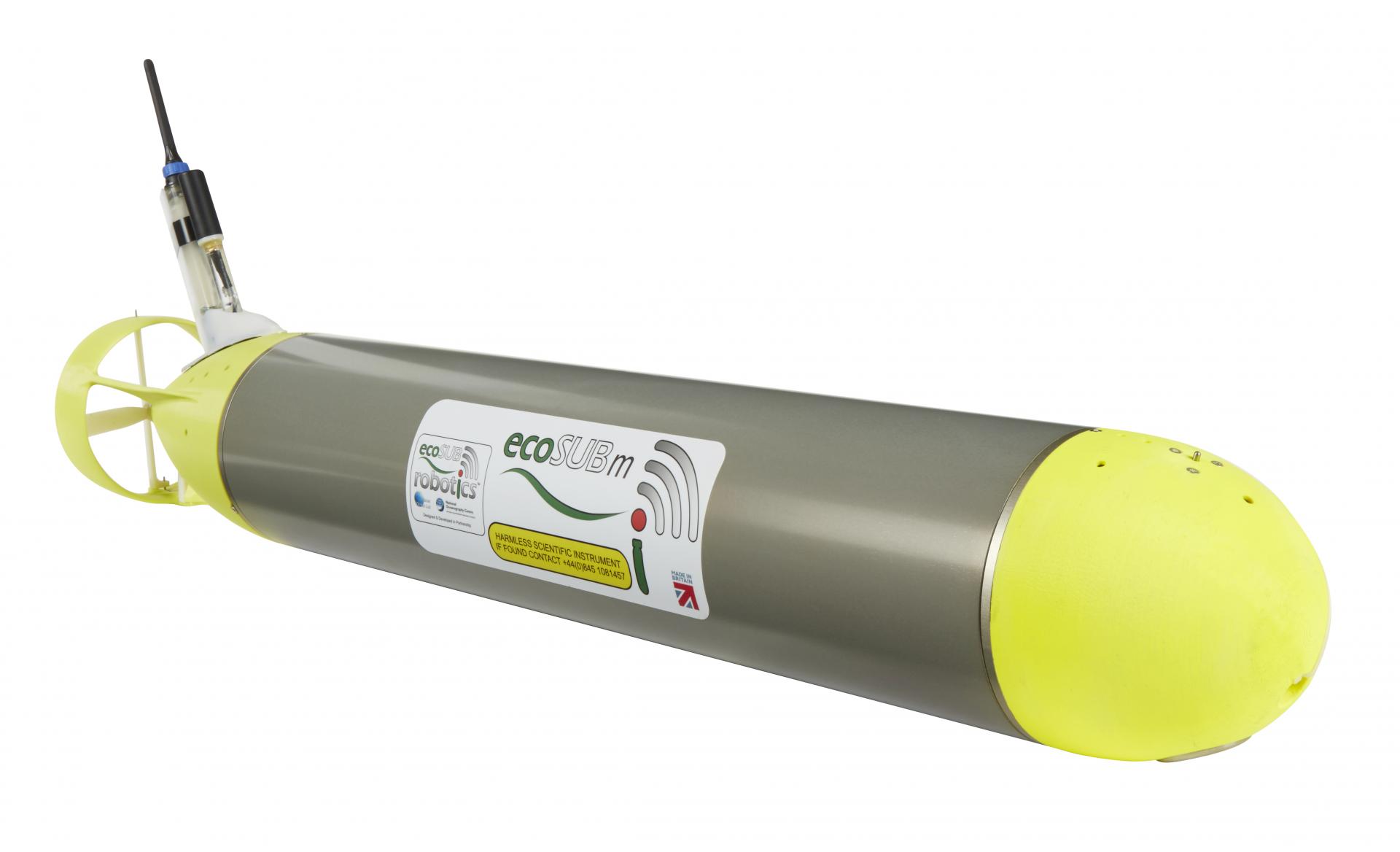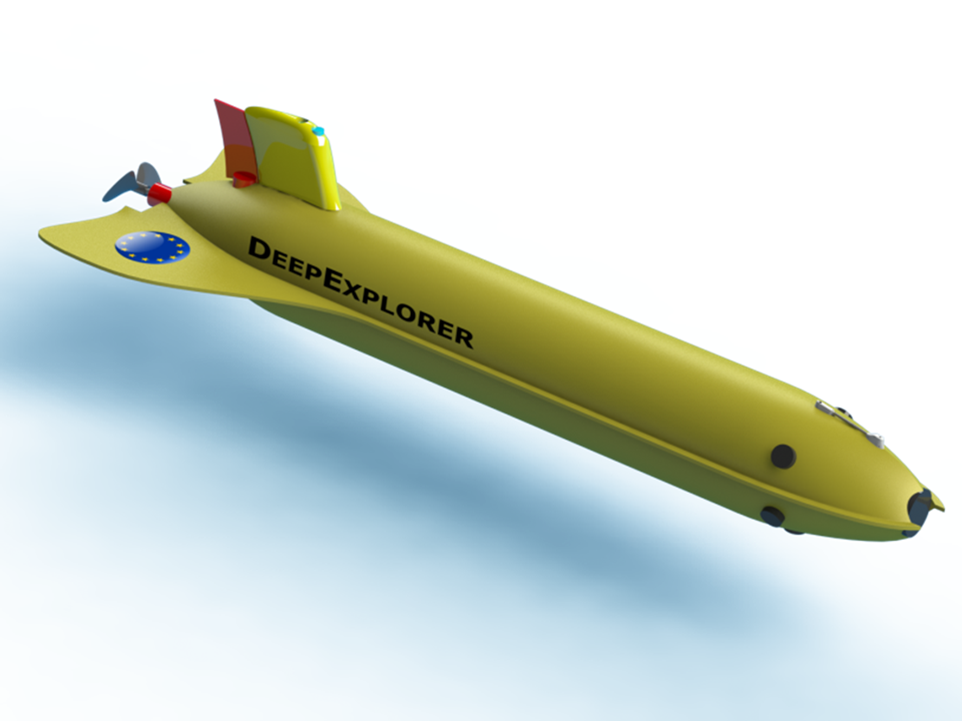Autonomous vehicles are the future of marine science. The ability to explore the oceans and collect data via unmanned, untethered robotic vehicles has greatly increased our scope of the oceans.
New and innovative autonomous vehicles being developed at the NOC are pushing the limits on how we can explore our oceans, with capabilities allowing us to reach new depths, travel under ice, take readings in remote areas and collect data during high sea states.
Autonomous vehicles can be deployed and remain at sea for several months, recording data and then transmitting the data back to shore when they surface. With so many questions about the physical, chemical and biological processes in our oceans, autonomous vehicles could provide the answers we are looking for. Current technology developments undertaken by the NOC are detailed below.
Auto-Hover 1
Auto-Hover 1 is NOC’s first hover-capable Autonomous Underwater Vehicle (AUV). It contains a total of 6 thrusters (3 vertical, 2 forward, 1 lateral) and is capable of being still as well as moving vertically in the water. The vehicle’s specialty will be surveying areas of the ocean vertically but it will also be capable of capturing imagery through the use of visual odometry systems.
NOC engineers Terry Wood and Shivan Ramdhanie give us an overview of the vehicle in the YouTube video below.
Auto-Hover 1: Our first hover-capable AUV
In development – Autosub2KUI
The development of Autosub2KUI at the NOC will provide the UK science community with a next generation, ship-launched, high-power, Autonomous Underwater Vehicle (AUV) capable of operating under ice.
The new Autosub2KUI will be designed so that it can operate from a range of research vessels including the UK’s RRS James Cook, RRS Discovery and the new Polar Research vessel, the RRS Sir David Attenborough.
Equipped with state-of-the art sonars and camera systems to enable scientists to create detailed maps and establish habitat characteristics of the seafloor, the new AUV will also have under-ice navigation capabilities so it can operate underneath vast areas of sea ice or glaciers. The systems on board will be designed to withstand pressure at 2,000m.
The new AUV will build on the successes of the current Autosub3 and Autosub6000 vehicles and exploit new Marine Autonomous Systems (MAS) technologies being developed in collaboration with industry partners at the NOC’s Marine Robotics Innovation Centre.
In development – ecoSUB, small, low-cost AUVs

The ecoSUB program began with an Innovate UK and DSTL funded project which included the development of the ecoSUBu for autonomous launch and recovery via an unmanned surface vehicle. Early stakeholder engagement in the ecoSUBu indicated the requirement for a larger vehicle – to meet the emerging needs of the oil and gas industry, ecoSUBm was quickly conceived.
Developed in partnership with the NOC, the ecoSUB engineering and development team are based in the Innovation Centre, benefiting from the facilities and expertise located within hub of UK marine autonomous systems development.
For further information, please visit the ecoSUB website
In development – Autosub Long Range 1500
Autosub Long Range (ALR-1500) will be our longest range AUV to date. With increased endurance and payload capacity, ALR1500 will be optimised for surveying the continental shelf and upper slope, with the potential to complete a full trans-Arctic mission, under ice.
The original ALR (ALR-6000) is an AUV capable of deployments of thousands of kilometres and lasting several months (depending upon sensor power drain and speed) with a maximum depth rating of 6,000m. For many application areas, such as measurements in shallow water, the 6,000m depth rating of the original ALR is not required, as measurements are concentrated in the upper water column. This gives an opportunity to design and manufacture a new version of the ALR with a shallower depth-rated pressure vessel.
This lower depth-rated pressure vessel will be designed to deliver a greater buoyancy and payload capacity, which can accommodate a battery pack 2.5 times larger than the ALR6000. This battery configuration will enable enough power for deployments with longer ranges, higher speeds, and the integration of more power-hungry sensors or navigation systems.
This development forms part of the Oceanids NERC Capital Project.
In development – BRIDGES deep glider project

The NOC, together with 19 public and private partners from scientific institutions, industries and innovative SMEs from nine countries have received €8 million funding from the European Union Horizon2020 programme to work on the development of two new deep-sea autonomous gliders.
The two ground-breaking Ultra(Deep) EXPLORER gliders with be adapted to operate at 2,400m (deep) and 5,000m (ultra deep) and will have new and enhanced sensing capabilities as well as providing unique and exciting opportunities for the monitoring of oceanographic features in the deep sea.
The BRIDGES project (Bringing together Industry for the Development of Glider Environment) aims to develop and demonstrate at sea two new deep-sea autonomous gliders.
These gliders, expected to be available to the market by 2020, will have new and enhanced sensing capabilities as well as providing unique and exciting opportunities for the monitoring of oceanographic features in the deep sea.
Gliders have a wide range of use for both oceanographic research and industry data collection. The capability of these new gliders to reach at least 75% of the ocean will open up new possibilities for science and industry. These include monitoring submarine biodiversity and conducting environmental impact assessments for potential seabed mining and exploration.
The BRIDGES consortium is made up of 19 public and private partners from scientific institutions, industries and innovative SMEs from nine countries and has received €8 million funding from the European Union Horizon2020 programme on ‘Unlocking the potential of seas and oceans’. The two ground-breaking Ultra(Deep) EXPLORER gliders with be adapted to operate at 2,400m (deep) and 5,000m (ultra deep).
The NOC will play a large role in the development of these new gliders, creating novel sensors deployed by the NOC and housed in the ‘nose’ of the glider to detect the presence of ‘plumes’ of sediment created by mining processes.
![BRIDGES glider project [image]](/files/images/technology/Technology_Development_BRIDGES2_960x640.jpg)
The development and integration of these sensors that can work at such extreme depths will be a real challenge as it is something that has not been done before and so the science behind it is really innovative. In addition to provision of the sensors, the NOC will also be responsible for the development of pressure tolerant structures within glider, its propulsion system, and testing it at sea. The final test is due to take place in September of 2019 off the south east of Ireland. NOC will use advanced ‘risk and reliability’ techniques to accurately quantify the risk of the glider failing under particular conditions.
Glider technology has proven to be one of most promising ocean observing techniques. Deep gliders have a strong role to play in operational oceanography, as well as enhancing our knowledge of the oceans.
These new gliders will be able to perform cost-effective research with multiple sensing, surveying and monitoring capabilities, while being, robust, re-locatable and easily-deployed with multiple sensing, surveying and monitoring capabilities to support long-term in-situ exploration and protection services of the coastal and deep ocean.